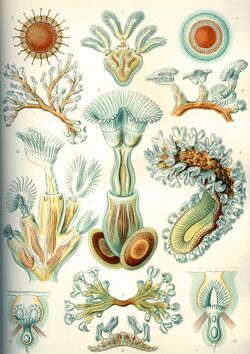Biology:Lophophorata
From HandWiki
Short description: Clade of shelled animals
| Lophophorata | |
|---|---|

| |
| Bryozoa | |

| |
| Brachiopod | |
| Scientific classification | |
| Domain: | Eukaryota |
| Kingdom: | Animalia |
| Subkingdom: | Eumetazoa |
| Clade: | ParaHoxozoa |
| Clade: | Bilateria |
| Clade: | Nephrozoa |
| (unranked): | Protostomia |
| (unranked): | Spiralia |
| Superphylum: | Lophotrochozoa |
| Clade: | Lophophorata Meglitsch, 1972 |
| Clades | |
| |
The Lophophorata or Tentaculata are a Lophotrochozoan clade consisting of the Brachiozoa and the Bryozoa.[1][2][3][4] They have a lophophore. Molecular phylogenetic analyses suggest that lophophorates are protostomes, but on morphological grounds they have been assessed as deuterostomes.[5] Fossil finds of the "tommotiid" Wufengella suggest that they evolved from worm-like animals that resembled annelids.[6][7]
| Lophotrochozoa |
| |||||||||||||||||||||||||||||||||||||||
References
- ↑ Temereva, Elena N.; Kuzmina, Tatyana V. (2017-07-31). "The first data on the innervation of the lophophore in the rhynchonelliform brachiopod Hemithiris psittacea: what is the ground pattern of the lophophore in lophophorates?". BMC Evolutionary Biology 17 (1): 172. doi:10.1186/s12862-017-1029-5. ISSN 1471-2148. PMID 28760135.
- ↑ Meglitsch, P.A. (1972). The Lophophorate Coelomates. in: Invertebrate Zoology 2nd ed. 671–697
- ↑ Luo, Yi-Jyun; Kanda, Miyuki; Koyanagi, Ryo; Hisata, Kanako; Akiyama, Tadashi; Sakamoto, Hirotaka; Sakamoto, Tatsuya; Satoh, Noriyuki (2017-12-04). "Nemertean and phoronid genomes reveal lophotrochozoan evolution and the origin of bilaterian heads". Nature Ecology & Evolution 2 (1): 141–151. doi:10.1038/s41559-017-0389-y. ISSN 2397-334X. PMID 29203924.
- ↑ Hausdorf, B.; Helmkampf, M.; Meyer, A.; Witek, A.; Herlyn, H.; Bruchhaus, I.; Hankeln, T.; Struck, T. H. et al. (2007-06-29). "Spiralian Phylogenomics Supports the Resurrection of Bryozoa Comprising Ectoprocta and Entoprocta" (in en). Molecular Biology and Evolution 24 (12): 2723–2729. doi:10.1093/molbev/msm214. ISSN 0737-4038. PMID 17921486.
- ↑ Jang, Kuem; Hwang, Ui (2009). "Complete mitochondrial genome of Bugula neritina (Bryozoa, Gymnolaemata, Cheilostomata): phylogenetic position of Bryozoa and phylogeny of lophophorates within the Lophotrochozoa" (in en). BMC Genomics 10 (1): 167. doi:10.1186/1471-2164-10-167. ISSN 1471-2164. PMID 19379522.
- ↑ Guo, Jin; Parry, Luke A.; Vinther, Jakob; Edgecombe, Gregory D.; Wei, Fan; Zhao, Yang et al. (2022). "A Cambrian tommotiid preserving soft tissues reveals the metameric ancestry of lophophorates". Current Biology 32 (21): 4769–4778.e2. doi:10.1016/j.cub.2022.09.011. PMID 36170853.
- ↑ Davis, Josh (29 September 2022). "An ancient hairy, armoured worm lived in the oceans over 500 million years ago". London: The Trustees of The Natural History Museum. https://www.nhm.ac.uk/discover/news/2022/september/ancient-hairy-armoured-worm-lived-oceans-over-500-million-years-ago.html.
Wikidata ☰ Q777853 entry
 |

